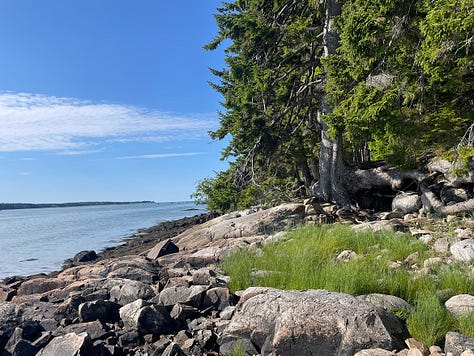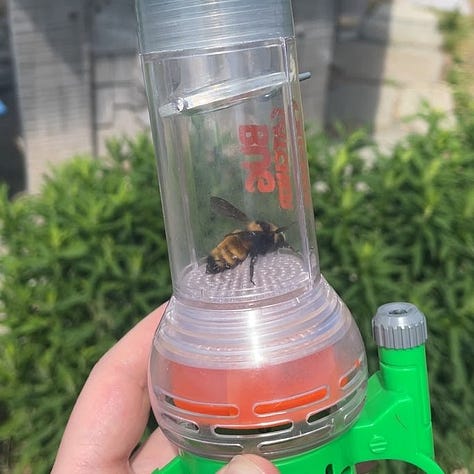Finding inspiration through “bee camp” and timeless folk music
A week with bee enthusiasts and our chance encounter with a folk icon
What comes to mind when you think of summer camp? For me, it’s nature exploration, fast friends, singing songs….
I was not much of camp kid, but wow, did I get the ultimate summer camp experience this past week in Maine.
Despite being three years into a PhD focused on native bees, I’ve never actually taken a basic entomology course, let alone one focused specifically on bees. I’ve been lucky to learn on the job from mentors and friends, but this summer, I decided that it was time to deepen my knowledge of bee natural history in a more formal way.
Last week, I had the chance to go to “bee camp,” also known as a week-long native bee seminar at the Eagle Hill Institute in Steuben, Maine. Taught by Tufts friends Nick Dorian and Max McCarthy (and TAed by the wonderful Rachael Bonoan & Kyle Rossner), it was a chance to sharpen my native bee ID skills, connect with friends old and new, and marvel at the ecology of Downeast Maine.



Bees were my gateway into being a naturalist. Paying attention to bees opened the door to noticing everything else. Put twenty or so bee-watching naturalists together, and you move at a snail’s pace, unraveling the endless stories that the natural world has to offer, if you just slow down and pay attention.
A few of my favorite nature encounters last week:
Finding bees at their nests: This female Ligated furrow bee (Halictus ligatus) is guarding her nest entrance, perhaps from parasites like bee flies or beetles.
The uncommon bees: We had the chance to admire a Northern amber bumble bee (Bombus borealis) queen, which is always a treat because they are negatively impacted by human development, making them often hard to find.
Microscopy: Looking at bees under a microscope opens up a new world of possibility. While many bees are field identifiable, some require a microscopic look to ID to species. Pictured here is a mason bee (Osmia sp.). Note the pollen collecting hairs (scopae) under her abdomen – a characteristic trait of female mason bees and leafcutter bees in the family Megachildae.
The non-bees: The white-spotted sawyer, a wood-boring beetle, is an example of another insect that calls the boreal forest home.
Bees as part of the food chain: Camouflaged in the sheep laurel, this crab spider ambushed a bumble bee worker for dinner.
The moth sheet: Nightlife at bee camp = staying up late watching moths. (More on that soon!)






Another reason that I made the trip to Eagle Hill was to connect with a community of pollinator people. While I love my grad program at UVM because it’s very interdisciplinary, I’m sometimes the only “bug person” in the room. I often miss the very insect-centric energy of my lab group at Tufts, where my interest in pollinators was first sparked. There's a special kind of magic in sharing the joy of insects with others who feel the same way. Knowing they’re out there, doing this work too, helps keep me inspired.
Despite all of the amazing nature encountered this past week at Eagle Hill, perhaps the most magical moment of them all was an unexpected encounter with a human: Noel Paul Stookey, “Paul” of the iconic folk trio, Peter, Paul and Mary.
Each night at bee camp we gathered after dinner for a lecture, storytelling, or a nature documentary… except for one night, where we got the opportunity to be a part of a spectacular night of music. Eagle Hill is not only a place for natural history education, but also holds a vast library, art collection, and hosts occasional concerts. Turns out, while he’s not touring, Noel Paul Stookey has called the coast of Maine home for decades. Eagle Hill sent him a long-shot request for a concert, never expecting him to actually reply and agree to play.
At 87 years young, he led us in an hour of music, perched in front of floor-to-ceiling windows displaying the spruce-fir forest behind him. Playing classics like “Garden Song,” “Puff the Magic Dragon,” “Wedding Song,” “Cue the Moon”, and of course, “If I Had A Hammer,” he shared stories of hope, resistance, love, and connection to the natural world.
(singing along to “One and Many” with Noel Paul Stookey)
My favorite part of all was that, well, at 87, he forgot the lyrics to his songs several times, but the devoted audience of folkies kept him on track, and he was delighted. There’s a nice lesson about taking care of each other in there.
Unfortunate as it may be that songs of resistance from over 50 years ago still ring true today, there’s a certain magic in singing them together—just like there’s magic in summer camp and nerding out about bees and the natural world. This week served as an important reminder about how powerful it is to gather with kindred spirits and feel part of something larger.
This immersive week at bee camp offered more than just a skill-building opportunity for my career, but also a chance to share stories, spark inspiration, and feel more connected to each other, the natural world, and the work at hand.
I’m so grateful for this week of bees and music on the coast of Maine. More stories to come. <3

Resources
If you live in the Eastern United States and want to learn more about the bees in your area, check out watchingbees.com. Through countless hours of bee watching, Nick and Max have created this incredible field guide for our region.
Create an account and upload your nature observations to iNaturalist, a global citizen science platform. AI helps you make a first guess at the species you’re looking at, but then experts can confirm that ID or suggest a new one. You can help scientists track insect populations by uploading your observations! You can find me at @leslie_spencer.
All photos my own unless otherwise noted.





You are so lucky to see Paul live! Sounds like a great week indeed. I'm going to check out the be site for east coast bees. I'm trying to attract more bees to my garden. I even convinced my Dad to plant native!
This is beautiful